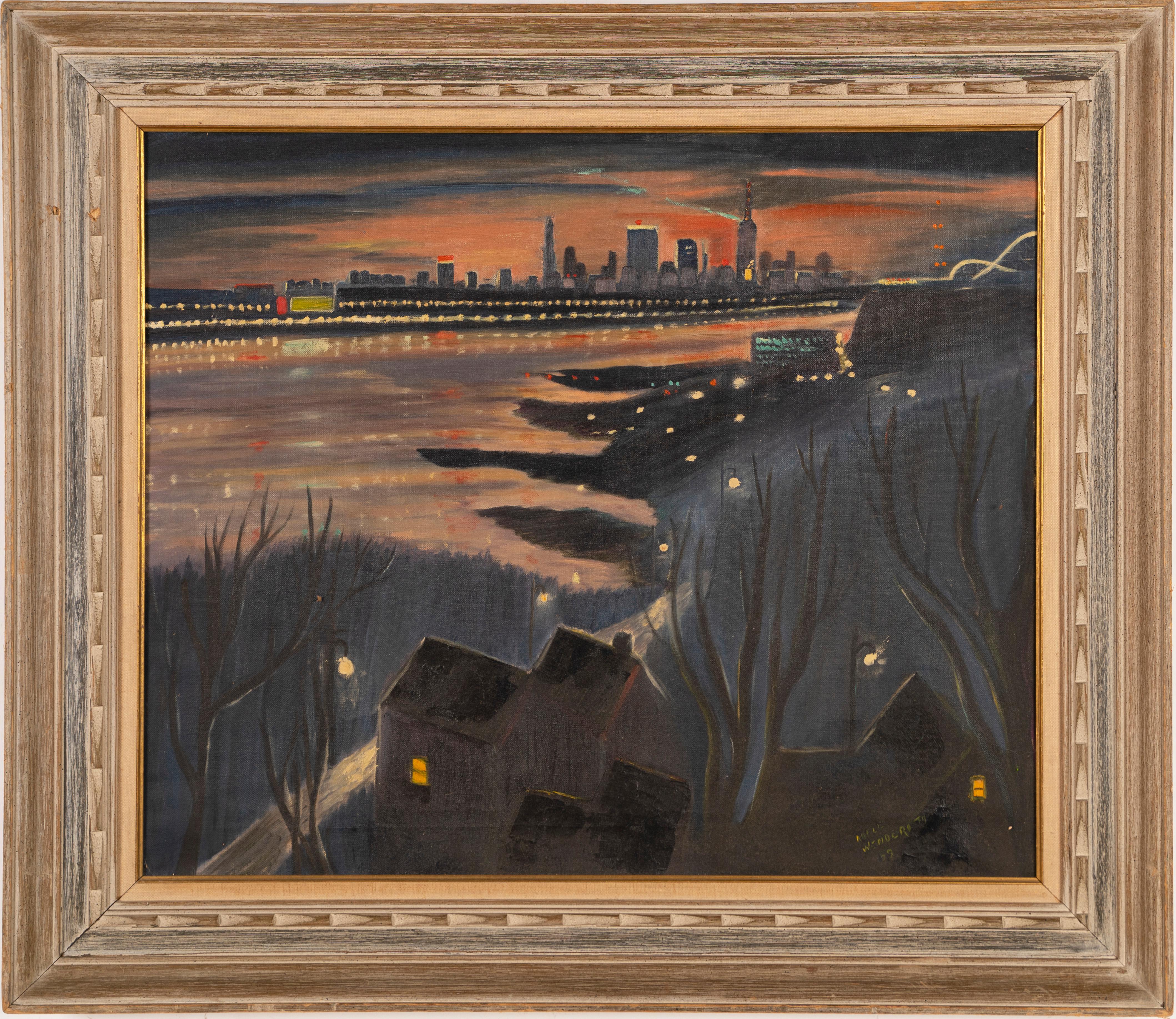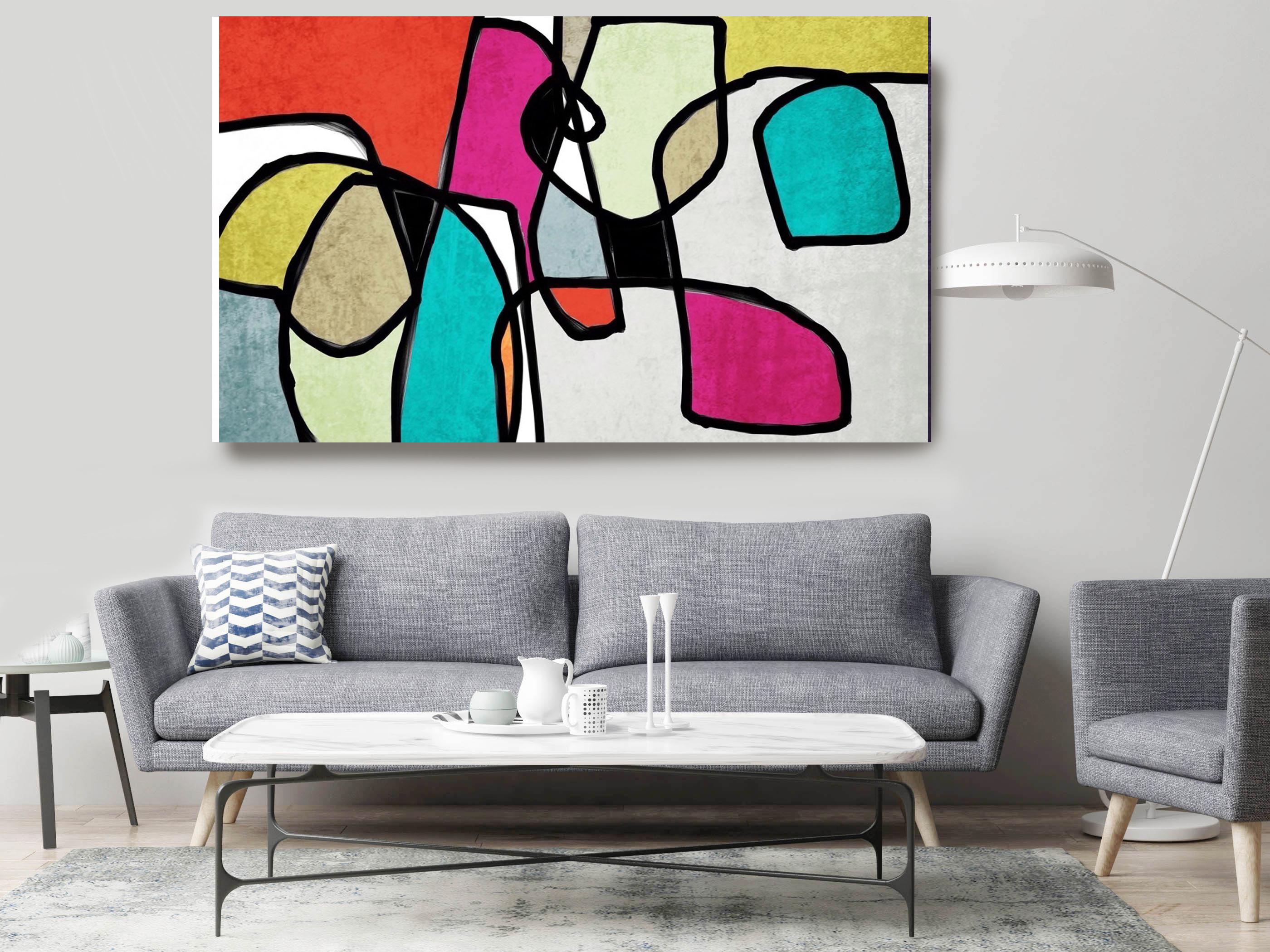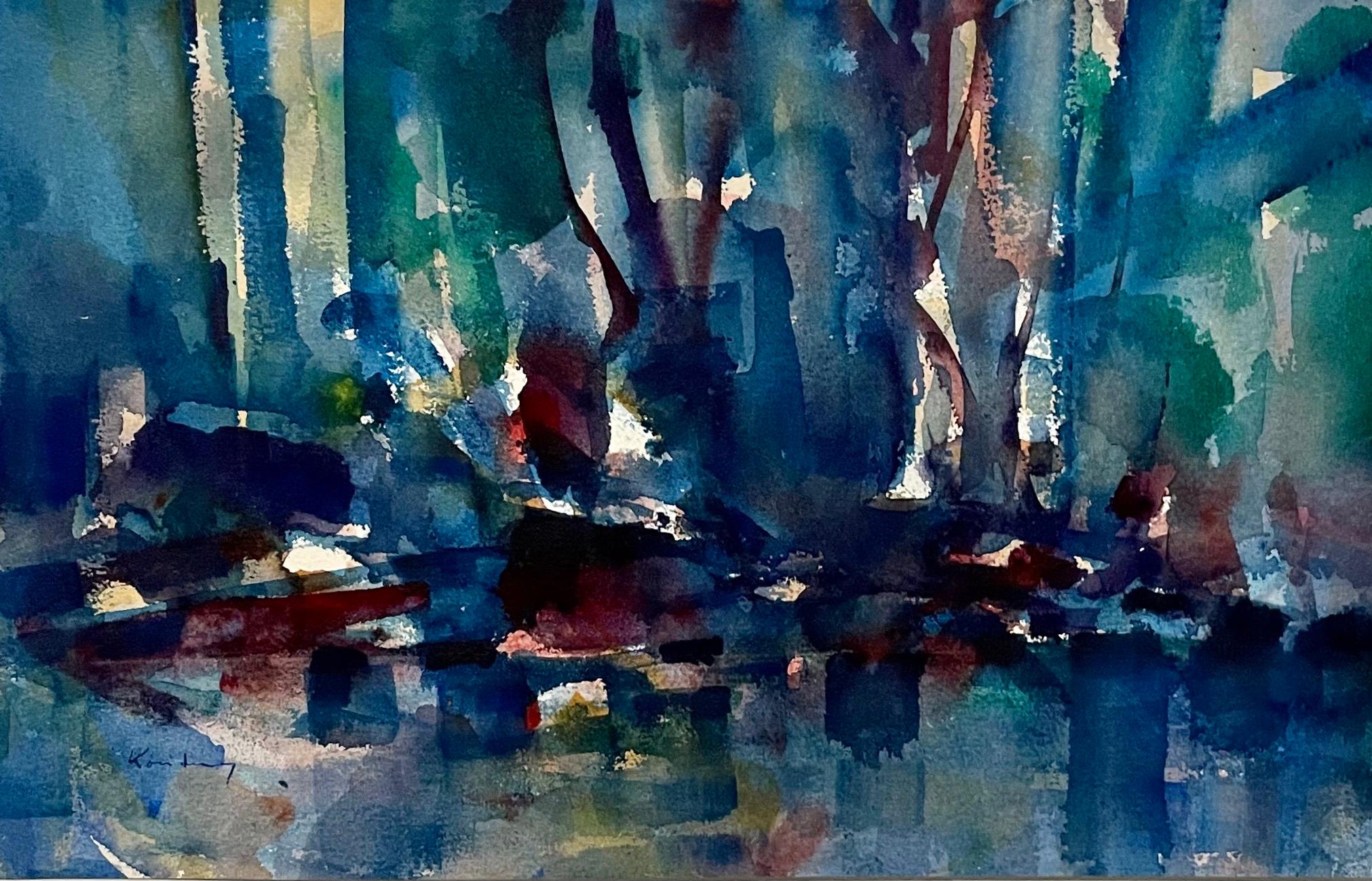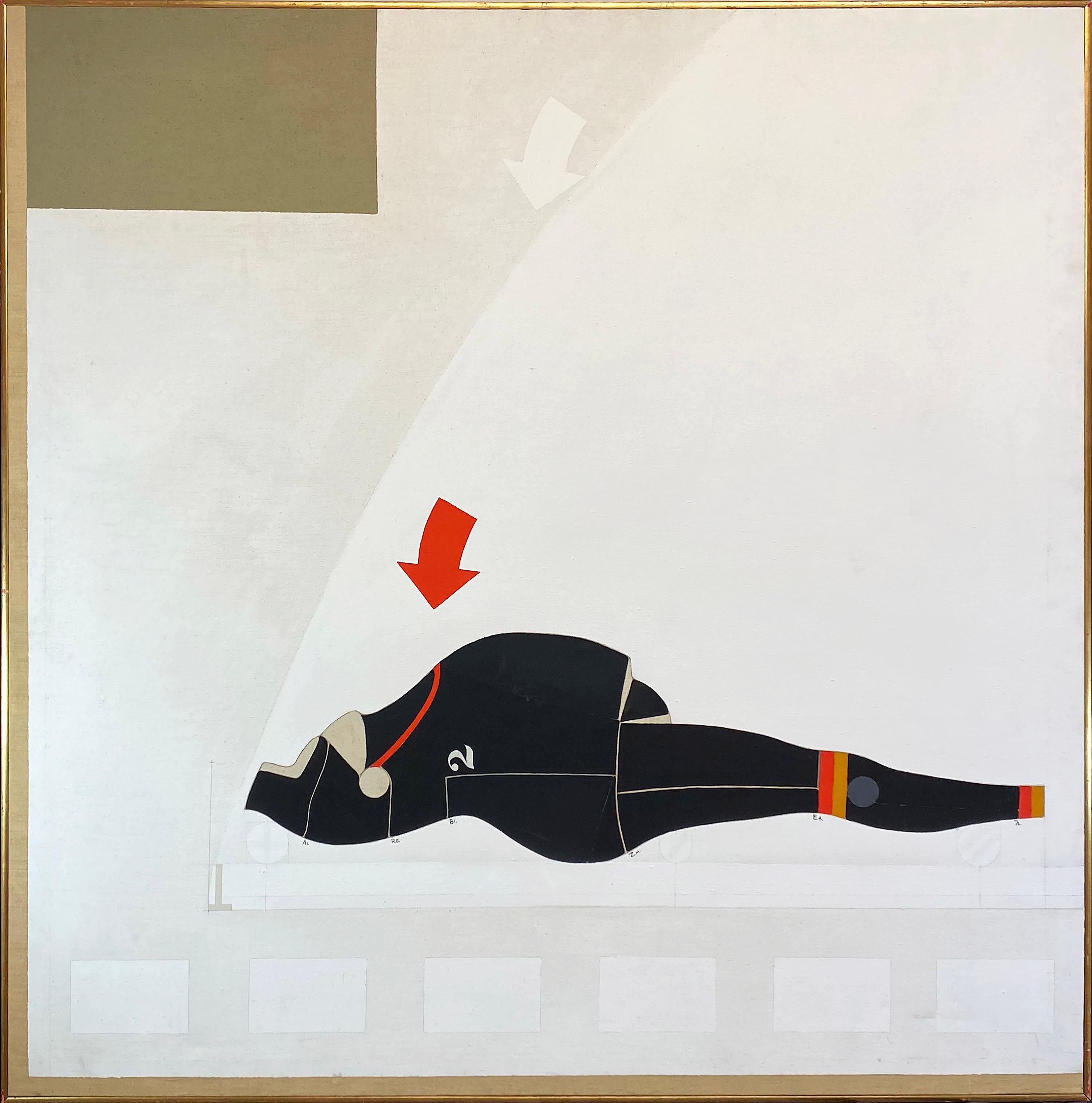Stanley Bate"South Bay, " 1970s Modern Abstract Oil Painting1971
1971
About the Item
- Creator:Stanley Bate (1903 - 1972, American)
- Creation Year:1971
- Dimensions:Height: 38 in (96.52 cm)Width: 50 in (127 cm)Depth: 1.5 in (3.81 cm)
- Medium:
- Movement & Style:
- Period:
- Condition:Gallery-wrapped canvas is professionally framed in a floater frame. 38 x 50 framed.
- Gallery Location:Westport, CT
- Reference Number:
Stanley Bate
Stanley Bate was born on March 26, 1903, in Nashville, Tennessee, to Henry C. and Nellie E. Freeman Bate. The Bates were an established Tennessee family Henry’s brother William Bate was the governor of Tennessee from 1883–87 and a United States Senator from 1887–1905. William was also a Major General in the Confederate Army during the Civil War and quite a colorful character. Henry and Nellie encouraged their son to seek formal education, but young Stanley eschewed proper schooling and instead chose to study art at the Watkins Institute in Nashville. In the 20s, Bate moved to New York City to study at the Art Students League under Frederick Bridgman. He soon landed a job with Encyclopedia Britannica, and from 1927–29, served as art editor.
From 1929 until he died in 1972, Bate was a self-employed artist. He taught art classes at both the Art Students League and the Albany Institute of History and Art and brought in extra income by making illustrations for magazines such as Outdoor Life and Popular Science. On January 27, 1934, Bate married Emilie Rossel. Emilie had emigrated from Switzerland to New York in 1923. She found work as a governess to Alfred Vanderbilt and later as an executive secretary for Wall Street investment brokers Kahn, Loeb and Co. Emilie met Stanley in New York in the early 30s when she attended one of his art exhibitions with a friend. The couple, who had no children, lived on 34th Street in Manhattan. During this period, Bate was producing and exhibiting his art and joined several artists groups. Stanley and Emilie became part of the New York art scene, dining weekly at the Society of Illustrators Clubhouse. Bate’s time in New York was pivotal in the formation of his painting style. He lived in New York during the inception of one of the most important Modern Art movements, one that helped New York replace Paris as the center of avant-garde art. This movement, which was called the New York School of Artists, was later known as Abstract Expressionism. It was composed of a loosely associated group of vanguard artists working in New York City during the 40s and 50s. The New York School was not defined by a specific style, but instead reflected a fusion of European Modernism and American social relevance that was depicted in many individual styles. Influences of Surrealism, Cubism, and Modernism can be found in their work, along with an interest in experimenting with non-traditional materials and methods. American art was at the forefront of international avant-garde for the first time.
Bate was undoubtedly exposed to the varied styles and techniques that were emerging during the formative years of the New York School. Mark Rothko and Robert Motherwell were formulating their versions of color field paintings. Joseph Cornell was experimenting with assemblages, collage and the use of different types of textured paints. Jackson Pollock was adhering objects such as buttons and coins into his early works, while Louise Nevelson was using found objects. Helen Frankenthaler added sand to her early paintings. The New York School artists were undermining traditional fine art by using mixed media and non-traditional methods. Bate absorbed these varied influences and soon his early realistic landscapes and still-lifes were replaced with something entirely new. The influence of Cubism, notably the flat shallow space of the picture plane, is obvious in many of his paintings. Surrealism is evident in the use of subjects from myth, primitive art and antiquity, along with the Automatism-like line work in his more linear images. The unfettered experimentation of the New York School is everywhere in Stanley’s work. We see nods to the color field, collage, the mixing of textures into the paint, mixed media, the inclusion of found objects and thick, luscious impasto. He was prolific and experimented in various media including oil, watercolor, lithography, silkscreen, woodcut, drawing, collage, ceramics and sculpture. He is considered a true Modernist. His work is largely abstract, but sometimes figures and buildings are discernable. He frequently mixed paint, sand and glue to achieve a textured surface, and then scraped and scratched through this layer to expose some of the underpainting below. His sculpture, which is often whimsical, also reflects the non-traditional methods of the New York School. He pioneered the use of enamel and copper in his work. The sculptures are not carved or modeled as was done in the past but instead are built using mixed media and new materials.
In addition to the New York School influence, many of his works exhibit a strong connection to the Spanish school, especially the work of Antonio Tapies and Modesto Cuixart. These artists were both a part of an avant-garde group known as Art Informel, the Spanish equivalent of Abstract Expressionism. These artists likewise worked in mixed media and introduced objects and texture into their work. Many of Bate’s subjects and titles relate to Spanish locations and words. It is likely that Stanley spent time in Spain and found inspiration there. By the early 40s, Stanley and Emilie had started spending weekends in a barn they purchased in Craryville, New York, a few hours north of Manhattan. The barn had no electricity or plumbing, but when the couple eventually decided to leave New York and live full time in Craryville, they remodeled the barn, putting a gallery downstairs and a studio and living quarters upstairs. Although the Bates moved out of New York City, Stanley remained part of the New York art scene, exhibiting in New York and elsewhere throughout the 50s and 60s. During his lifetime, he was represented by the New York galleries Knoedler and Company, Kennedy Galleries, Rose Fried Gallery and Key Gallery, along with Tyringham Gallery located in Tyringham, Massachusetts. Craryville was Stanley’s home until his death on August 21, 1972. Emilie died in 1984. Her obituary requested that any donations be made to the Albany Institute of History and Art. The Institute held a retrospective exhibition of Bate’s work in 1973. Since his death, Bate’s artwork has been exhibited widely and placed in numerous collections.
- ShippingRetrieving quote...Ships From: Westport, CT
- Return PolicyThis item cannot be returned.
- "Martos, " 1960s Modern Abstract PaintingBy Stanley BateLocated in Westport, CT"Martos" is an abstract oil painting on canvas by Stanley Bate featuring what appears to be a high horizon line of white and muted yellow. Beneath that line is a combination of textu...Category
1960s Modern Abstract Paintings
MaterialsCanvas, Oil
- "Great Wall, " 1970s Modern Abstract PaintingBy Stanley BateLocated in Westport, CTThis Modern abstract oil painting on canvas by Modernist artist Stanley Bate features a geometric composition and a soft palette. The white and creme colors are complemented by earth...Category
1960s Modern Abstract Paintings
MaterialsCanvas, Oil
- "Mazarrón, " 1960s Modern Abstract PaintingBy Stanley BateLocated in Westport, CTIn this Modern abstract painting by Stanley Bate, a bold palette is married with imperfect shapes and large brush strokes. Sandy beige rectangles blend with yellow and deep blue, on ...Category
1960s Modern Abstract Paintings
MaterialsCanvas, Oil
- "Birthday, " 1960s Modern Abstract PaintingBy Stanley BateLocated in Westport, CTThis Modern Abstract Expressionist painting by Stanley Bate is made with oil paint on canvas. It features a muted, earth-toned palette with contrasting warm yellow, orange, and red accents throughout. The painting is framed in a floater frame with gold face and black sides. It is 22" x 36" and measures 24" x 38" x 2" framed. This painting is not signed by the artist, but has been authenticated by his estate. It is stamped with the estate seal on the back of the painting, and on the back of the frame. Ready to hang. Stanley Bate was born on March 26, 1903 in Nashville, Tennessee. The Bates were an established Tennessee family, in fact, Henry’s brother William Bate was the governor of Tennessee from 1883-1887 and a United States Senator from 1887-1905. Stanley studied art at the Watkins Institute in Nashville. In the 1920’s Bate moved to New York City to study at the Art Students League under Frederick Bridgman. He soon landed a job with Encyclopedia Britannica, and from 1927-1929 served as art editor. From 1929 until his death in 1972, Stanley was a self-employed artist. He taught art classes at both the Art Students League and the Albany Institute of History and Art and brought in extra income by making illustrations for magazines such as “Outdoor Life” and “Popular Science”. On January 27, 1934 Stanley married Emilie Rossel. Emilie had emigrated from Switzerland to New York in 1923. She found work as a governess to Alfred Vanderbilt and later as an executive secretary for Wall Street investment brokers Kahn, Loeb and Co. Emilie met Stanley in New York in the early 1930’s when she attended one of his art exhibitions with a friend. The couple, who had no children, lived on 34th Street in Manhattan. During this period, Bate was producing and exhibiting his art and joined several artists groups. Stanley and Emilie became part of the New York art scene, dining weekly at the Society of Illustrators Clubhouse. Stanley Bate’s time in New York was pivotal in the formation of his painting style. He lived in New York during the inception of one of the most important Modern Art movements, one that helped New York replace Paris as the center of avant-garde art. This movement, which was called the New York School of artists, was later known as Abstract Expressionism. It was comprised of a loosely associated group of vanguard artists working in New York City during the 1940s and 1950s. The New York School was not defined by a specific style, but instead reflected a fusion of European Modernism and American social relevancy that was depicted in many individual styles. Influences of Surrealism, Cubism, and Modernism can be found in their work, along with an interest in experimenting with non-traditional materials and methods. American art was in the forefront of international avant-garde for the first time. Stanley Bate was undoubtedly exposed to the varied styles and techniques that were emerging during the formative years of the New York School. Mark Rothko and Robert Motherwell were formulating their versions of color field paintings. Joseph Cornell was experimenting with assemblages, collage and the use of different types of textured paints. Jackson Pollock was adhering objects such as buttons and coins into his early works, while Louise Nevelson was using found objects. Helen Frankenthaler added sand to her early paintings. The New York School artists were undermining traditional fine art by using mixed media and non-traditional methods. Stanley Bate absorbed these varied influences and soon his early realistic landscapes and still-lifes were replaced with something entirely new. The influence of Cubism, notably the flat shallow space of the picture plane, is obvious in many of Bate’s paintings. Surrealism is evident in Bate’s use of subjects from myth, primitive art and antiquity, along with the Automatism-like line work in his more linear images. The unfettered experimentation of the New York School is everywhere in Stanley Bate’s work. We see nods to color field, collage, the mixing of textures into paint, mixed media, the inclusion of found objects and thick, luscious impasto. Bate was prolific and experimented in various media including oil, watercolor, lithography, silk screen, wood cut, drawing, collage, ceramics and sculpture. Bate is considered a true Modernist. His work is largely abstract, but sometimes figures and buildings are discernable. He frequently mixed paint, sand and glue together to achieve a textured surface, and then scraped and scratched through this layer to expose some of the underpainting below. His sculpture, which is often whimsical, also reflects the non-traditional methods of the New York School. Bate pioneered the use of enamel and copper in his work. The sculptures are not carved or modeled as was done in the past, but instead are built using mixed media and new materials. In addition to the New York School influence, many of Bate’s works exhibit a strong connection to the Spanish school, especially the work of Antonio Tapies and Modesto Cuixart. These artists were both part of an avant-garde group known as Art Informel, the Spanish equivalent of Abstract Expressionism. These artists likewise worked in mixed media and introduced objects and texture into their work. Many of Bate’s subjects and titles relate to Spanish locations and words. It is likely that Stanley spent time in Spain and found inspiration there. By the early 1940s, Stanley and Emilie had started spending weekends in a barn they purchased in Craryville, New York, a few hours north of Manhattan. The barn had no electricity or plumbing, but when the Bates eventually decided to leave New York and live full time in Craryville, they remodeled the barn, putting a gallery downstairs and a studio and living quarters upstairs. Although the Bates moved out of New York City, Stanley remained part of the New York art scene, exhibiting in New York and elsewhere throughout the 50s and 60s. During his lifetime he was represented by the New York galleries Knoedler and Company, Kennedy Galleries, Rose Fried Gallery and Key Gallery, along with Tyringham Gallery located in Tyringham, Massachusetts. Craryville was Stanley’s home until his death on August 21, 1972. Emilie died 1984...Category
1960s Modern Abstract Paintings
MaterialsCanvas, Oil
- "Entr' Acte, " 1960s Modern Abstract PaintingBy Stanley BateLocated in Westport, CTThis Modern abstract figurative painting by Stanley Bate features abstracted figures in motion, placed in front of a geometric background with white, maroon, and blue squares tiled n...Category
1960s Modern Abstract Paintings
MaterialsOil, Canvas
- "Survivors, " 1960s Modern Abstract PaintingBy Stanley BateLocated in Westport, CTThis Modern painting by Abstract Expressionist Stanley Bate was made with oil on canvas circa 1960. It features a cool blue and grey palette along the perimeter, with warmer muted gr...Category
1960s Modern Abstract Paintings
MaterialsCanvas, Oil
- Antique Large Modernist Interior View Fauvist Palette Original Oil PaintingLocated in Buffalo, NYAntique large modern interior scene oil painting. Oil on canvas, circa 1920. Unsigned. Image size 35.5L x47.5H.Category
1930s Modern Interior Paintings
MaterialsCanvas, Oil
- Antique American Sunset Cityscape Signed Landscape River Nocturnal Oil PaintingLocated in Buffalo, NYAntique American modernist sunset cityscape painting. Oil on canvas, circa 1959. Signed. Image size 20L x 24H. Housed in a period modern frame.Category
1950s Modern Landscape Paintings
MaterialsCanvas, Oil
- Mid Century Modern Oil Painting Canvas 48 x 71" Vibrant ColorfulBy Irena OrlovLocated in Sherman Oaks, CAMid Century Modern Oil Painting Canvas 48 x 71" Teal Pink SPECIFICATIONS: - Fine art canvas - Professionally hand stretched over 1 ½" deep wood stretched bars. The edges are painted...Category
2010s Modern Abstract Paintings
MaterialsCanvas, Oil
- Modernist Abstract Expressionist Watercolor Painting Bauhaus Weimar Pawel KontnyBy Pawel KontnyLocated in Surfside, FLAbstract watercolor composition bearing the influence of the earlier color-block compositions of Paul Klee. Pawel August Kontny, (Polish-German-American artist) He was born in Laurahuette, Poland, in 1923, the son of a wealthy pastry shop owner. In 1939 he began studying architecture in Breslau where he was introduced to the European masters and to the work of some of the German Expressionists, soon afterward banned as "degenerate artists" and removed from museums throughout Germany by the Nazi regime. His studies were interrupted by World War II. Drafted into the German army, traveling in many countries as a soldier, he sketched various landscapes but in 1945, he was captured and held as a prisoner of war in Italy. After the war, he studied at the Union of Nuremberg Architects to help design buildings to replace ones destroyed in the war. He recorded his impressions of the local population and the landscapes through his watercolors and drawings. Pawel Kontny thereafter moved to Nuremberg, Germany, becoming a member of the Union of Nuremberg Architects and helping to rebuild the city's historic center. He soon decided to concentrate on his professional art career. He married Irmgard Laurer, a dancer with the Nuremberg Opera. Pavel Kontny 's career as an artist was launched with his participation in an all German exhibition, held at the Dusseldorf Museum in 1952. He held one-man shows in Germany, Switzerland and the United States. During his trip to the United States in 1960, Kontny became instantly enamored with Colorado, and decided to relocate to Cherry Hills with his wife and two children. He quickly established himself in the local art community, being affiliated for a time with Denver Art Galleries and Saks Galleries. His subject matter became the Southwest. During this time he received the Prestigious Gold Medal of the Art Academy of Rome. His extensive travel provided material for the paintings he did using his hallmark marble dust technique. he also worked equally in pastel, watercolor, charcoal and pencil-and-ink. in a style which merged abstraction and realist styles, influenced by Abstract Expressionist painting and South Western American landscapes. In the early 1960s he was one of only a few European-born professional artists in the state, a select group that included Herbert Bayer (1900-1985), a member of the prewar Bauhaus in Weimar and Dessau, Germany, and Roland Detre (1903-2001), a Hungarian modernist painter. As a Denver, Colorado resident, Pavel Kontny exhibited at galleries and museums throughout the United States, Germany and Japan. There, he was inspired by frequent trips to Native American pueblos in the Southwest, as well as by the study of the Plains Indians of Montana and Wyoming. Over the years Kontny had a number of students and generously helped young artist by hosting exhibitions at his Cherry Hills home. For many years he generously donated his paintings to support charitable causes in Denver. Influences during his European years included German pastelist C.O. Muller, German Informel painter Karl Dahmen and Swiss artist, Hans Erni. In the early 1950s his painting style showed the influence of the Die Brücke (The Bridge), a group of German expressionist artists formed in Dresden in 1905 who had a major impact on the evolution of modern art in the twentieth century in Germany. By the middle of the decade his style incorporated more referential abstraction and total abstraction, resulting in part from his study of Hans Hartung, a German artist based in Paris who exhibited his gestural abstract work in Germany. The American moon landing in 1969 inspired Paul Kontny...Category
20th Century American Modern Landscape Paintings
MaterialsCanvas, Oil
- Abstract HorizontalLocated in Missouri, MOKen Anderson (20th century) was active/lived in United States. Ken Anderson is known for Abstract hanging sculpture. *See included images and videoCategory
1980s American Modern Abstract Paintings
MaterialsCanvas, Wood, Mixed Media, Oil, Handmade Paper
- Falling Man, Black on White BackgroundBy Ernest Tino TrovaLocated in Missouri, MOFalling Man, Black on White Background by Ernest Tino Trova. 52.5" x 52.5" Known for his Falling Man series in abstract figural sculpture, he created ...Category
Late 20th Century American Modern Abstract Paintings
MaterialsCanvas, Oil






